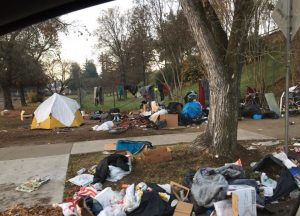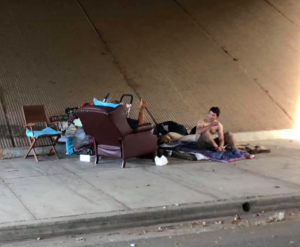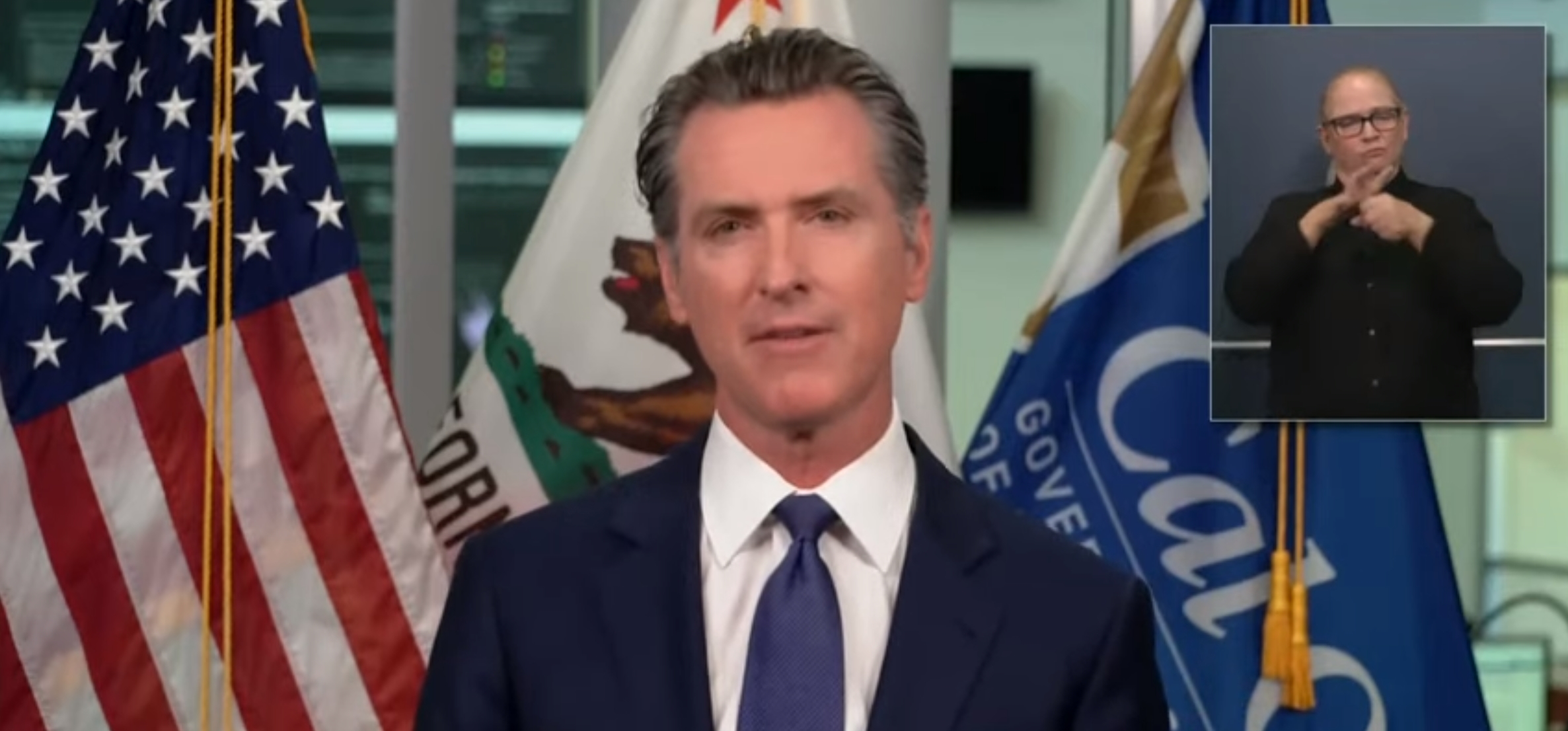
Governor Gavin Newsom. (Photo: Kevin Sanders for California Globe)
Gov. Newsom’s Billion$ for Homelessness Amount to California Stimulus
‘Housing first’ policy ends up harming the very people it purports to help
By Katy Grimes, January 14, 2020 3:38 pm

“You’ll start seeing real progress in the next few months,” Gov. Gavin Newsom said at his 2020 Budget Briefing Friday, addressing California’s homeless crisis. “Mobile tents, medical units, FEMA trailers… as early as next week.”
“We put $650 million emergency grants to cities and counties,” Newsom said Friday, but he admitted the state did not release the money to cities and counties last year. “The $650 million hasn’t gone to cities and counties yet – but it’s going out as we speak. This is unprecedented in California history,” Newsom said. “The money is finally going out on homelessness.”
Following the briefing, Gov. Newsom’s task force on homelessness called for a “legally enforceable mandate” that would force municipalities and the state to house the growing number of homeless Californians, Dan Walters at Calmatters reported. “The proposal, which came as Newsom kicked off a weeklong tour of the state aimed at drawing attention to the homelessness crisis, urged the Legislature to put a state constitutional amendment on the November ballot that would force California cities and counties to take steps to provide housing for the more than 150,000 Californians who lack it, or face legal action.”

Nearly every Californian has already noticed the homeless crisis, with drug addicted vagrants living and defecating on city streets, along rivers, under freeways, in parks, on vacant lots, in vacant homes, in RVs, and wherever they can squat.
So Newsom’s homeless task force wants to force cities to provide housing, when housing is not the prevailing problem… mental illness and drug addiction is, as is the state’s policy of prison population reduction, early release programs, bail “reform,” and reducing felonies to misdemeanors and misdemeanors down to citations for a notable list of crimes under Propositions 47 and 57.
Notably, Los Angeles county and city governments collectively spend more than $1 billion annually on the costs of dealing with the growing homeless population, which continues to grow with their spending.
Newsom said the state has committed trailers and medical tents to the homeless, “but we need to focus on permanency. This means regionalizing our administration. It needs more accountability at the local level.”
“I’m the Homeless Czar in the State of California,” Newsom added. “We’re going to start hitting on all cylinders.”
California Stimulus
However, the billions of dollars coming from the taxpayers via the governor to California’s cities will act as another “stimulus program” for housing construction, similar to Obama’s American Recovery and Reinvestment Act of 2009, ostensibly designed to save existing jobs and create new ones as soon as possible. This could be a positive move for California if the housing was not for drug-addicted street people and vagrants, and instead for young first-time homebuyers, empty-nesters and people looking to downsize, and more affordable housing options for working class families and renters.
How is it that the state’s large illegal immigrants population always manages to find housing in California?
Again treating the homelessness problem as housing problem, Newsom said he is creating a $750 million housing and services fund. “We’re going to engage landlords directly. It will be the first in the nation. It’s not without its administrative hurdles. There’s going to be a multi-year effort to begin to leverage each other, as opposed to leverage from each other. We will force and compel partnerships.”
Nearly 75 percent of homeless people struggle with substance abuse disorders. So for recovering addicts and domestic violence survivors, a one-size-fits all “housing first” policy ends up harming the very people it purports to help by placing them in “no barrier shelters” with addicts, criminals and abusers.
Gov. Newsom’s Homeless Task Force
Gov. Newsom’s homeless task force, led by former California Senate President pro Tem Darrell Steinberg, now Sacramento’s Mayor, and Los Angeles County Supervisor Mark Ridley-Thomas, both Democrats from cities overrun by drug-addicted vagrants, say the “task force seeks to identify critical dimensions and answer the key question: In a context in which the federal government has drastically reduced housing investments and may be departing from evidence based approaches to addressing homelessness, how can we best use state public policy and resources to incentivize and require our state and local governments to scale the evidence-based practices and make this intolerable condition dramatically better?”

The “evidence-based approaches to addressing homelessness” made mandatory under President Obama, and their “housing first” policy, never addressed why these people were living on the streets in their own filth like animals, nor did it address that California’s housing problems mostly stem from state-imposed regulations and environmental requirements, tacking on hundreds of thousands of dollars to each home even before ground is broken.
The task force’s report calling for mandates on cities to provide housing makes the Ninth Circuit Court of Appeals decision on Martin V. Boise even worse.
“The state must establish in law that it is not morally or legally acceptable to deny housing for people on the streets and create the legal mandates and funding mechanisms necessary to dramatically improve this unacceptable condition,” the task force came up with. “All levels of government responsible for and impacted by this crisis must demonstrate a greater sense of urgency.”
The Homeless Quandary website has tackled the Ninth Circuit decision legally, and highlights that many cities appear more afraid of homeless advocates’ ongoing lawsuits than a sincere reading and interpretation of the decision.
A few highlights:
*Martin vs Boise was narrower than many cities are claiming. It seems clear to me for instance, that while sleeping overnight in public places is protected by the ruling, setting up permanent camps is not.
*some cities may be using the Martin vs Boise ruling as an excuse, and not as legitimate rationale, to justify their refusal to act on the massive problems and nuisance caused by out of control growth of homeless camps. I find dubious some cities’ claims that they are worried about being sued if they try to clean up encampments.
*excessive scrutiny of the kind of shelter or quality of shelter being offered, is problematic and interferes with the city’s ability to keep order in its public spaces.
*the Martin vs Boise case doesn’t really make clear, at least as far as I’m aware, whether the shelter offered to homeless by a city, needs to be in that city or close by. This issue of the burden required to be borne by any particular city vis a vis the homeless who happen to show up there, I predict will be heard by a high court eventually, as this is an issue that is imperative to sort out.
Homeless task force chairman Sacramento Mayor Darrell Steinberg is an attorney and has a bevy of attorneys at his disposal. For he and Supervisor Ridley-Thomas to come up with a constitutional amendment mandating cities build housing instead of offering solid legal leadership statewide is pure state government overreach… and perhaps some crony capitalism thrown in. The billions of dollars likely won’t really make it down to much needed homeless drug treatment and mental health services, but instead will go to the developers of homes and apartment complexes – also much needed, but for employed California residents.
Sonoma had a plan to buy up large homes and turn them into group homes for homeless. But that plan didn’t fly with people who had purchased their homes in the neighborhoods where these supposed group homes would have been. Sonoma just announced yesterday they were scrapping that plan, but denied it was because of homeowner pressure, the Press Democrat reported:
“Last month, Sonoma County supervisors approved nearly $12 million to support a number of short- and longer-term housing options for trail camp residents, including $5.5 million to buy six large houses that would serve up to 60 trail residents.”
“The Davis Street house, a seven-bedroom, three-bathroom home, drew ire from some West End neighbors neighborhood concerned the area was overrun with existing services for the homeless population and others in need.” Ya think?
“To use the homes as the county envisions, county staff will spend up to $50,000 on furniture and have banked another $500,000 to relocate current tenants — another consequence of the purchase that has elicited public criticism.”
Sonoma’s controversial plan also would have evicted the current renters of the homes, perhaps creating more homeless.

Another of the task force’s recommendations is “Exempt from CEQA all actions taken in furtherance of creating high-quality housing opportunities for people at risk of or experiencing homelessness.”
The homeless currently live on the streets, like these guys (left). Those who do not want to live on the streets typically get themselves into shelters and programs designed to help with addiction and mental illness, but require accountability.
The other homeless are severely drug addicted and/or mentally ill, and as most police and fire officers report, they refuse services, housing, mental health or addiction programs. This fixation of “high-quality housing” is about as arbitrary and arrogant as giving a 10-year old the keys to the Mercedes… both the high-quality housing and the Mercedes will end up destroyed.
Read the INTERIM REPORT FROM THE GOVERNOR’S COUNCIL OF REGIONAL HOMELESS ADVISORS
- Gov. Newsom’s and AG Bonta’s Affordable Housing Shakedown Scheme - April 25, 2024
- 6 California Cities Make the Least Affordable List for Home Buyers - April 24, 2024
- NEW REPORT: California Ranks Among Bottom of 50 States for Financial Transparency - April 23, 2024





Everyone must hear this. The only reason I’m posting it is because I looked everywhere and couldn’t find coverage of Newsom’s Riverside stop on his Homeless Photo-Op Tour that wasn’t a puff piece or that gave a real sense of what is going on here. I know you all know, but just LOOK at how the Tour is being presented, and with the help of much of the CA press. Oh, and also, did you realize that YOU are to blame, by wanting something serious done about this, by “passing judgment” and wanting to pursue your daily lives without threat of random violence and disease? This was the message implicit in self-anointed theologian and saint Gavin’s comments:
“Newsom Visits Riverside” – John and Ken, KFI-AM 640:
https://www.spreaker.com/user/kfiam640/01-14-20-jk-pod
(Segment begins at 99:35, goes for about 7 mins)
Sticking drug-addicted mentally ill vagrants in group homes in residential neighborhoods is going to be very expensive and will not provide what these people need, treatment and rehab. Temporary shelters and tent cities are no better. These are band aid approaches to the problem. People who have serious mental illness, and hard core drug addicts need a structured institutional setting dedicated to getting positive outcomes for those capable of reaching them, and long term maintenance for those who can’t. Group homes and walk-in rehab programs don’t deliver this. California will need to site sizable campuses, preferably in unused government and commercial buildings, with services consolidated to triage the homeless and provide detox, rehab and job skills for substance abusers, referral to mental institutions for the chronically mentally ill. But the state will also have to change it “values” from permitting drug dealing, addiction, public intoxication and property crimes to one that provides consequences for these behaviors.
“People who have serious mental illness, and hard core drug addicts need a structured institutional setting dedicated to getting positive outcomes for those capable of reaching them, and long term maintenance for those who can’t. Group homes and walk-in rehab programs don’t deliver this.”
EXACTLY.
We used to have State Hospitals for this purpose and at one point last year there were whisperings that L.A. County intended to bring back into use at least one of the old structures, which still exists, and I presume push for laws (or removal of laws) that would make it possible to remove addicts and the mentally ill from the street and provide the disciplined care they need. But that hopeful and common sense baby step in the right direction went away, drowned out I guess by Newsom and Steinberg and Garcetti and the rest and their “Housing First” coalition; you know, the group that has made and will make more piles of dough off of the misery of the tortured souls on the street. The “Homeless Industrial Complex.”
Newsome spent $1.5 BILLION in San Francisco on the ‘homeless’ issue and solved nothing.
SF Chronicle just scrubbed if from their site (wonder why) but here it is in google cache.
https://webcache.googleusercontent.com/search?q=cache:slr4atFM9OUJ:https://www.sfchronicle.com/archive/item/A-decade-of-homelessness-Thousands-in-S-F-30431.php+&cd=1&hl=en&ct=clnk&gl=us
Wow, thanks for digging up that article. Gavin Newsom hasn’t changed, and the policies of the entire SF crowd highlighted in the piece were clearly doomed to fail (with Angela Alioto’s efforts POSSIBLY being the least of the bad, but still not effective). I hope we can see this more clearly now that they HAVE failed and the situation is more out of control than ever. But I won’t hold my breath.
Broken Window Theory (cleaned up New York under Giuliani) is the best way to go, and moving toward state treatment institutions, and getting rid of Props 47 and 57 and AB 109, but fat chance that will happen now with Chesa Boudin as D.A. and the SF culture of virtue-signaling instead of doing what works. Everyone suffers because of this situation, not least those on the street. The usual suspects’ response is not “love” as the rank-and-file progressives seem to think.